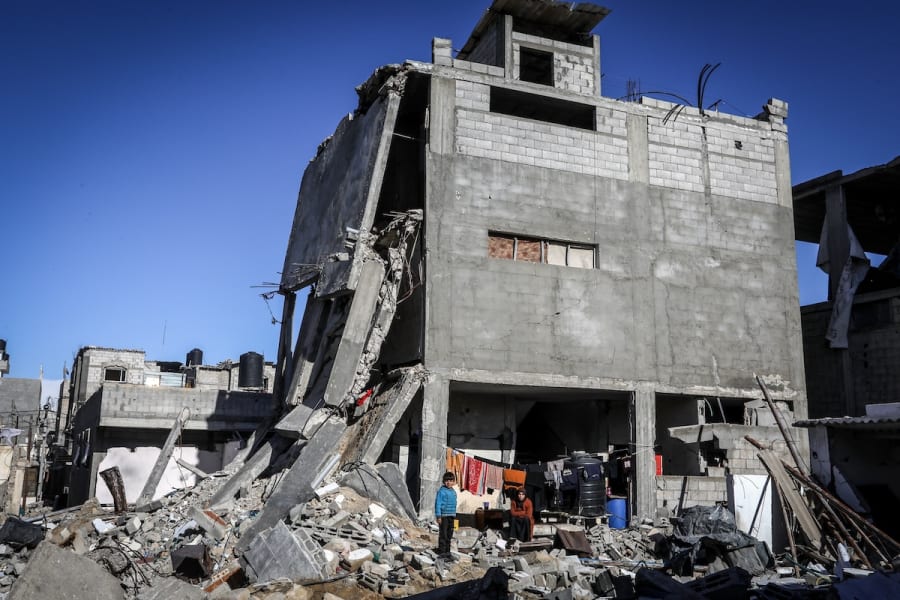‘An enemy in every house’ - Massive scale of Hamas terror structures causes IDF shortage of explosives
Israel forced to raze entire neighborhoods to destroy tunnels and battle stations

Since the beginning of the Israeli ground offensive into the Gaza Strip in late October, videos of the Israel Defense Forces blowing up buildings or entire blocks of houses have become some of the most iconic imagery of the war.
For Israelis, the detonations of terror infrastructure, mostly tunnels, shafts, hidden weapon depots, etc., symbolize the eradication of the terrorist infrastructure responsible for the horrors of Oct. 7.
For Palestinians and many in international media, these pictures symbolize what they see as Israeli atrocities and war crimes. Footage showing the destruction of mosques, UN-affiliated schools and university buildings, in particular, drew wide condemnation.
Even the U.S. Biden administration has raised concerns about the demolition of the university, and Husam Zomlot, the Palestinian ambassador to Britain, accused Israel of purposefully making the area “unliveable and lifeless” to prevent Gazans from returning.
A recent report from the New York Times implied that some demolitions were carried out as acts of revenge, and documented at least 33 demolitions of hundreds of buildings, including mosques and schools.
When you compare the size of Gaza to London, insane that Hamas built an underground military tunnel network reportedly 1.5 times the length of the Tube. Every shaft in a school, home, mosque, hospital, or UNRWA facility. So much wasted potential for Gaza under Hamas. For what? pic.twitter.com/nPWrt0kbVx
— Eylon Levy (@EylonALevy) January 31, 2024
However, IDF officials say the demolitions correspond to the unbelievable scale of the terror infrastructure in the Strip that has been described by Israeli officials repeatedly and that many soldiers have testified to personally since entering the Gaza Strip.
“These are 100% houses that were identified as hostile, and before [the demolition] we take pictures of every such house and document weapons inside or terrorists we have killed. When we say that we meet an enemy in every house, it is not a cliché,” an IDF officer told Israel’s Ynet news.
“In all the neighborhoods we were in, there are ready-made Hamas battle stations – weapons, tunnels, charges, launch positions, all inside residential houses, some of which were also prepared with openings in the walls for passing between buildings,” said journalist Roi Yanovsky from Channel 13 news after his stint in the IDF reserves.
The IDF responded to a query by the NYT that Israeli soldiers are “locating and destroying terror infrastructures embedded, among other things, inside buildings” in civilian areas and that sometimes entire neighborhoods were turned into “combat complexes” for Hamas fighters.
Some of the demolitions seem to be part of an Israeli plan to create a protective buffer zone inside the Gaza Strip to prevent any future terror attacks from Gaza, as the Israeli government reportedly informed its Arab neighbors and the United States.
Earlier this month, 21 IDF soldiers were killed when a Hamas RPG activated numerous explosive charges that were intended to destroy 10 buildings near Kibbutz Kissufim, only about 600 meters (less than a half mile) from the border fence.
IDF Spokesman Brig.-Gen. Daniel Hagari said the operation was part of an effort to secure the border areas so Israeli citizens could safely return to their homes.
However, in addition to the creation of the buffer zone, the sheer scale of the terrorists' infrastructure in Gaza necessitates widespread demolitions – and despite this, a recent report suggested that only between 20% to 40% of Hamas’ terror tunnel network has been destroyed so far.
The seemingly never-ending number of structures used by terrorists has even led to a shortage in explosive charges and has given rise to a new phenomenon of Israeli soldiers burning buildings to render them unusable.
This started as a local initiative by an IDF unit in the Shejaiya neighborhood, one of the most famous Hamas strongholds, and spread from there to other sectors, Ynet reported.
“There are thousands of houses and buildings in the Gaza Strip, perhaps tens of thousands, that are used by Hamas. In the Gaza Strip, there are cities, not villages, and in these cities, there are large neighborhoods with buildings of 5, 10, and 15 stories… used by Hamas,” IDF officers told Ynet.
“In this sense, the Gaza Strip is not a small area, but an organized and urban terror state,” they added and explained that some units even developed techniques to concentrate the fire only in one building and prevent its wider spread.
The need became so great that IDF soldiers have begun only demolishing staircases in hostile buildings to prevent their immediate use, where Hamas operatives would be able to shoot at Israeli forces or observe them from the upper floors of the buildings.
In response to the Ynet report, the IDF spokesman said: “Explosions and destructions of buildings are done with approved and appropriate means. Actions done in other ways during the war will be investigated.”

The All Israel News Staff is a team of journalists in Israel.













